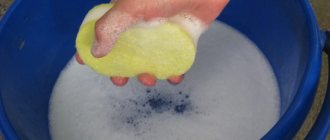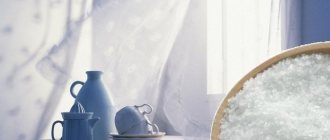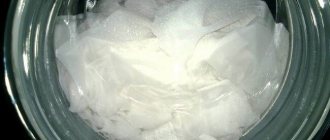One of the popular types of tulle fabric for decorating windows in the house is organza. Thin, weightless and almost transparent material, among other things, is characterized by high strength and rigidity, thanks to which it holds its shape well. However, the positive properties also make the finished product difficult to care for, so it will be useful to learn how to wash organza and what bleaching, drying and ironing methods are suitable for this fabric.
Is it possible to wash organza curtains in an automatic washing machine?
Despite its thinness and lightness, organza tolerates machine washing well. To preserve the properties of the fabric, you must follow simple rules when choosing the operating mode of the washing machine, the appropriate detergent and the number of spin speeds. A special mesh laundry bag will help make the task easier and reduce the risk of organza damage. An important condition is the absence of the slightest damage and the processing of the edges of the curtains. You can find out how to process the edge of organza in your nearest studio or in specialized literature.
Important! Organza should not be washed together with other fabrics, and the fabric should also be sorted by color. This will avoid staining the material, the appearance of streaks and disruption of the structure.
Selecting the optimal mode
Modern washing machines allow you to select the desired washing mode suitable for various fabrics. The sequence of actions depends on the degree of contamination of the tulle curtains. How to properly machine wash organza:
- You can load curtains into the drum without pre-soaking if the fabric only needs light cleaning and there are no stains or heavy dirt.
- Before washing organza kitchen curtains, you should first rinse them in cool water and remove fat deposits.
The delicate wash program in an automatic washing machine requires a low temperature, gentle handling of the product and a low spin speed. Organza after this treatment looks fresh and does not require further processing. After washing, the curtains can be immediately hung on the curtain rod.
Setting the appropriate temperature
Organza curtains do not withstand high temperatures well, losing their elasticity, lightness and acquiring a dirty gray tint. Using hot water causes dirt and dust to literally stick to the fibers of the fabric, complicating the cleaning process and making washing ineffective. In the delicate mode in the washing machine, a temperature of 30-35 degrees is used, it is in this range that it is possible to preserve the properties of organza and wash the curtains without deformation or loss of appearance.
Selection of detergent
Organza is a delicate fabric and requires a picky choice of detergent. Powders have good cleaning properties, but lead to increased foaming. It is difficult to wash out the remaining foam from the spaces between the tulle fibers, so such curtains should be washed using liquid gels. The amount of liquid detergent depends on the brand, so before washing organza in the machine, you should carefully study the instructions.
Features of the material
Organza is often used for sewing curtains and drapes. This is a thin, rigid fabric made of polyester, viscose or silk. Modern technologies make it possible to make edges on tightly twisted transparent threads. Due to this, the canvas sparkles and shimmers in the light.
Several types of organza are available:
- smooth;
- reaped;
- single color;
- multi-colored;
- iridescent (chameleon).
Curtains are often decorated with printed patterns, figured perforations, and embroidery. The material can have any shade or combine several colors. Additional shine is added by gold or silver plating.
Despite its thinness and airiness, the fabric is difficult to tear. Due to this, organza wears out for a long time. Improper care can damage the material: the use of aggressive substances, mechanical stress, ironing at high temperatures.
Hand wash without ironing
Moderately soiled curtains can be washed by hand and, if done correctly, you won't have to iron them. When washing, liquid detergents and low temperatures are also used, and before immersion in water, the curtains are inspected for fabric damage and stains.
Procedure for washing organza products:
- Dilute liquid detergent in warm water.
- Dip the curtains into the resulting solution.
- Using light blotting movements, saturate the fabric with water and leave the curtains for 10-15 minutes to get the effect of the detergent.
- Lightly beat the fabric and rinse in plenty of water.
After hand washing, organza curtains do not have to be ironed if you immediately hang them back on the curtain rod.
Important! Excess water can be removed by gentle squeezing, but the fabric should not be twisted, squeezed or wrinkled.
Whitening organza curtains at home
Folk remedies or household bleaches can help restore the whiteness of fabric after unsuccessful washing in hot water or bleach curtains that have lost their original appearance. You cannot use bleaching agents containing chlorine for washing, therefore, before bleaching organza, you should carefully study the instructions or read the contents of the recipe.
Options for whitening organza curtains at home:
Saline solution
- Saline solution. Among folk remedies, a good result is obtained by using salt, which is added to a regular detergent in the soaking mode. After washing in a saline solution, the tulle acquires a pleasant shine, the whiteness returns, and in addition, the density of the fabric increases, so the curtain acquires a starching effect.
- Lemon juice. Adding citric acid when soaking organza curtains helps restore gloss to the fabric, eliminate yellowness and give the fabric a subtle citrus aroma.
- Oxygen household bleaches. Ready-made products save time, but can be too aggressive towards delicate fabric. Before bleaching organza at home, it is advisable to test the effect of the bleach on a small, inconspicuous area of tulle or a piece of fabric left after sewing curtains.
Important! The procedure for bleaching organza is carried out only after preliminary washing, otherwise stains and dirt will become more noticeable than before.
We recommend:
How to wash a coat at home
How to bleach organza
You can bleach organza curtains and tulle using industrial or improvised means. Industrial bleaches are divided into three groups:
- Chlorine - contains bleach and surfactants. The most famous representative is “Whiteness”. It is effective, but aggressive and can damage matter. It damages the skin of your hands, so you need to use the product with gloves.
- Oxygen-containing - contain hydrogen peroxide. Representatives: Vanish, Amway, Bos Plus. They are non-toxic and cause little damage to fabric. However, they are effective only at a temperature of 80 degrees; organzas are not suitable for washing.
- Optical brighteners - contain fluorescent pigments. They mask stains on fabric.
The means at hand are less aggressive, but it is not always possible to bleach an item the first time.
View this post on Instagram
Publication from MAGNIT COSMETIC KRASNAYA POLYANA (@magnitkosmetikkr) January 16, 2021 at 5:10 PST
Baking soda
It is easy to bleach organza using a mixture of washing powder and baking soda. Mix a handful of washing powder and a tablespoon of soda and add 5 liters of water. Soak the curtain in the solution for an hour. Then it is washed by hand or in a machine using a special mode.
To watch a video on how to bleach fabric:
Dishwashing liquid
Not the most effective way to bleach curtains. Take 50 ml of dishwashing detergent per liter of water and soak the product. After an hour, rinse thoroughly.
With salt
Dissolve 2 tablespoons of table salt in a liter of water. Soak the curtain or dress, pour a little salt on the stains and rub lightly. Leave for an hour. After soaking, the product is rinsed and hung to dry.
You can bleach the product based on the video:
Using green or blue
You can bleach a grayed item with brilliant green antiseptic. First, the fabric must be washed in the usual way. Dissolve 10 drops of brilliant green in a liter of cold water and stir thoroughly. Soak the curtain for half an hour, then rinse.
When bleaching with blue, you should take 10 ml of product per liter of water. The washed item is soaked in the solution for an hour, then rinsed generously.
For more detailed instructions, watch the video:
Use of starch
A glass of starch is dissolved in three liters of warm water. Soak the curtain for three hours, then wash as usual.
Laundry soap
Laundry soap contains a lot of alkali, so it effectively whitens organza. The method is labor-intensive, but the most effective. Grind a bar of soap on a grater. Pour in three liters of water and bring to a boil.
Place the curtain in the hot solution and soak for 12 hours. Then rinse thoroughly and hang to dry.
The second way to bleach a product with laundry soap is to boil it. Prepare a soap solution as described above. Place the pan with the solution on low heat so that the temperature does not exceed 40 degrees. Place the product there and cook for 60 minutes, constantly turning over. Afterwards rinse thoroughly.
To see how to wash a product with soap:
Kefir or yogurt
Fermented milk products remove the gray tint from things. To bleach a curtain, you should soak it in yogurt or low-fat kefir. Then wash as usual and rinse thoroughly.
Acetylsalicylic acid
You can bleach yellowed tulle with aspirin. A pack of tablets is dissolved in a liter of warm water, and the product is soaked for two hours. Then it is thoroughly rinsed.
View this post on Instagram
Publication from Guzel Yusupova (@yusupova_guzel_) December 7, 2021 at 12:15 PST
Lemon acid
Cleanses light stains and removes yellowness. First, the product is washed in the usual way. Then soak it in a liter of water with a dissolved sachet of citric acid. After half an hour, rinse with clean water.
View this post on Instagram
Posted by Ekaterina (@katrin____vesna) Jan 20, 2021 at 2:13 PST
Ammonia and peroxide
The fastest way to whiten organza curtains. You need to mix ammonia and peroxide in a ratio of 1:2, pour into a bowl of water. Soak the item in a basin for half an hour. Then rinse thoroughly and hang the curtains on the curtains.
Do I need to starch organza?
Impregnation of the material with a special composition, as a result of which the rigidity of the fabric increases, is called the starching process. This method not only increases the density of the product, but also increases wear resistance and resistance to stains. Usually, a specially prepared starch-based solution is used for this purpose, although there are ready-made household chemicals that simply need to be diluted according to the instructions. Whether to starch tulle curtains or not is up to each housewife to decide on her own, since with increasing rigidity the process of giving shape becomes more complicated, and the decorative effect of the tulle also decreases.
How to quickly starch organza:
- Rinsing curtains in a cold saline solution increases density without weighing down the fabric.
- The use of starch is undesirable due to the possible appearance of yellowness on the curtains.
- Ready-made products should be intended for delicate fabrics and should be used in clearly specified proportions.
Tips for drying organza curtains
To make curtains look wrinkled and untidy after washing, it is customary to iron them, but in the case of delicate tulle fabric, precautions should be taken.
How to properly process organza for smoothing:
- Instead of an iron, it is better to use a steamer. This device will allow you to straighten the curtains already hung on the cornice and eliminate the possibility of damage to the fabric.
- Hot iron and organza are incompatible concepts. Curtains made of delicate fabric can only be ironed with a warm iron, using thin material as a cushioning agent.
It is best to hang the organza curtains in their original place after washing and let them straighten on their own.
Caring for delicate organza is not difficult if you follow simple washing and ironing rules. In any case, each item has its own shelf life, and if the tulle in the room is no longer pleasing to the eye, and all the measures taken to “revive” it have not brought results, then it’s probably worth updating the decor and bringing something new into the interior.
How to bleach organza tulle
Organza is a beautiful, translucent, stiff fabric that makes stunning embroidered or beaded designs. It is unpretentious and transmits light well. But organza attracts dust just as well, wrinkles and loses its shape after washing.
So, to bleach tulle, we will need:
- 250 g potato starch;
- 5 liters of water.
Pour warm water into a bowl and add starch. Stir thoroughly so that there are no lumps left.
Soak the tulle in the solution for 2–4 hours, and then, without wrung out, hang it to dry. Place a tray under the curtains to avoid drips on the floor.
This method will not only refresh the color of the organza, but also smooth out any creases in the fabric.











